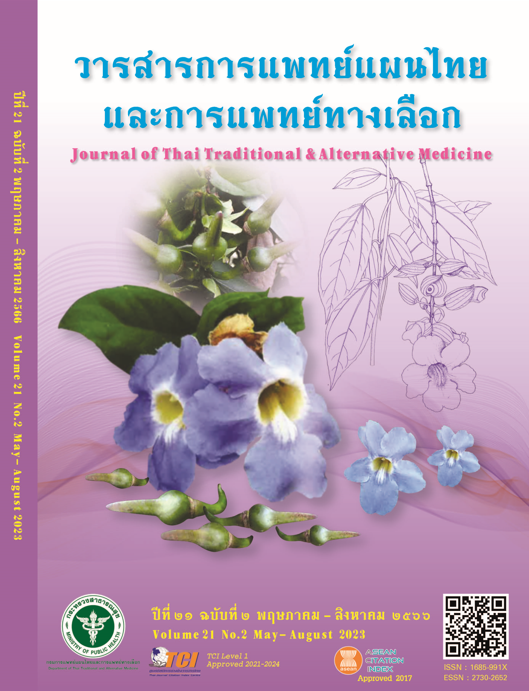การเปรียบเทียบฤทธิ์ยับยั้งเชื้อแบคทีเรียที่ก่อให้เกิดสิว ฤทธิ์ยับยั้งการอักเสบและปริมาณฟีนอลิกของสารสกัดจากใบรางจืดสดและแห้ง
Main Article Content
บทคัดย่อ
บทนำและวัตถุประสงค์ สิวเป็นโรคผิวหนังที่พบอาการบวม แดง อักเสบ หรือติดเชื้อ เช่น เชื้อแบคทีเรีย Cutibacterium acnes และ Staphylococcus aureus โดยทางการแพทย์แผนไทยนิยมใช้สมุนไพรในการรักษาโรค รางจืด (Thunbergia laurifolia Lindl.) มีสารสำคัญกลุ่มฟีนอลิกเป็นองค์ประกอบหลักและเป็นสมุนไพรที่นิยมใช้รักษาโรคทางผิวหนัง แก้ไข้ แก้อักเสบ ปวด บวม สารสกัดจากใบรางจืดแห้งเคยมีรายงานเกี่ยวกับฤทธิ์ยับยั้งการเจริญของเชื้อ C. acnes แต่ยังไม่มีการเปรียบเทียบฤทธิ์ของใบรางจืดสดและแห้งมาก่อน ดังนั้นการศึกษาครั้งนี้มีวัตถุประสงค์เพื่อศึกษาฤทธิ์ของใบรางจืดในการต้านเชื้อแบคทีเรียที่ก่อให้เกิดสิว ฤทธิ์ต้านการอักเสบและปริมาณสารฟีนอลิก และการเปรียบเทียบผลของใบรางจืดสดและแห้งและชนิดของตัวทำละลายที่ใช้ในการสกัด
วิธีการศึกษา การศึกษาฤทธิ์ต้านเชื้อแบคทีเรียใช้เทคนิค broth microdilution assay เพื่อหาค่าความเข้มข้นต่ำสุดในการยับยั้งการเจริญเติบโตของเชื้อแบคทีเรีย การวิเคราะห์หาปริมาณสารฟีนอลิกใช้เทคนิค Folin-Ciocalteu และการศึกษาฤทธิ์ต้านการอักเสบในเซลล์ RAW264.7 โดยการวัดปริมาณไนตริกออกไซด์
ผลการศึกษา ผลการทดลองพบว่าสารสกัดใบรางจืดสดมีปริมาณสารฟีนอลิกสูงกว่าใบรางจืดแห้ง และสารสกัดชั้นเอทานอลของใบรางจืดสดมีฤทธิ์ในการยับยั้งเชื้อ C. acnes และ ต้านการอักเสบโดยยับยั้งการหลั่งไนตริกออกไซด์ได้ดีที่สุด ส่วนฤทธิ์ยับยั้งเชื้อ S. aureus มีเพียงสารสกัดจากใบรางจืดสดเท่านั้นที่มีฤทธิ์
อภิปรายผล จากการทดลองครั้งนี้พบว่าใบรางจืดสดมีฤทธิ์ดีกว่าใบรางจืดแห้ง อีกทั้งสารสกัดที่ได้จากการสกัดด้วยเอทานอลยังมีฤทธิ์ที่ดีกว่าสารสกัดที่ได้จากการต้มน้ำ อุณหภูมิสูงอาจส่งผลให้สารสำคัญในใบรางจืดสลายตัว ดังนั้นใบรางจืดแห้งและสารสกัดชั้นน้ำมีฤทธิ์ที่ต่ำกว่าใบรางจืดสดที่สกัดด้วยเอทานอล
ข้อสรุป สรุปได้ว่าใบรางจืดสดมีฤทธิ์ยับยั้งเชื้อแบคทีเรียที่ก่อให้เกิดสิวและฤทธิ์ต้านการอักเสบได้ดีกว่าใบรางจืดแห้ง และวิธีการสกัดที่เหมาะสมคือการแช่สกัดในเอทานอล ดังนั้นใบรางจืดสดที่สกัดด้วยเอทานอลจึงเหมาะที่จะนำไปพัฒนาเป็นผลิตภัณฑ์รักษาสิวต่อไปในอนาคต
Article Details

อนุญาตภายใต้เงื่อนไข Creative Commons Attribution-NonCommercial-NoDerivatives 4.0 International License.
เอกสารอ้างอิง
Zaenglein AL, Pathy AL, Schlosser BJ, Alikhan A, Baldwin HE, Berson DS, Bowe WP, Graber EM, Harper JC, Kang S, Keri JE, Leyden JJ, Reynolds RV, Silverberg NB, Gold LFS, Tollefson MM, Weiss JS, Dolan NC, Sagan AA, Stern M, Boyer KM, Bhushan R. Guidelines of care for the management of acne vulgaris. J. Am. Acad. Dermatol. 2016;74(5):945-73.
Liu H, Archer NK, Dillen CA, Wang Y, Ashbaugh AG, Ortines RV, Kao T, Lee SK, Cai SS, Miller RJ, Marchitto MC, Zhang E, Riggins DP, Plaut RD, Stibitz S, Geha RS, Miller LS. Staphylococcus aureus epicutaneous exposure drives skin inflammation via IL-36-mediated T Cell responses. Cell Host Microbe. 2017;22(5):653-66.
Ayer J, Burrows N. Acne: more than skin deep. Postgrad Med J. 2006;82(970):500-6.
Wat Po traditional medical and ayuravate association. Thai traditional medicine code. 2nd Ed. Bangkok: Traditional medical and ayuravate association; 1975. 454 pages.
Chaloemram C, Sedlak S. Study on knowledge of medicinal plant formulas for dermatitis treatment recorded in palm leaf manuscripts of Isan. KKU Sci J. 2020;48(3):350-63.
Wutthithammawet W. Encyclopedia of Thai herbs and medicinal plants for therapeutic use. Bangkok: Odeonstore publishing; 1997. 618 pages.
Chan E, Eng SY, Tan Y, Wong Z. Phytochemistry and pharmacological properties of Thunbergia laurifolia: A review. Pharmacogn J. 2011;3(24):1–6.
Chaiyana W, Chansakaow S, Intasai N, Kiattisin K, Lee K-H, Lin W-C, Lue S, Leelapornpisid P. Chemical constituents, antioxidant, anti-MMPs, and anti-hyaluronidase activities of Thunbergia laurifolia Lindl. leaf extracts for skin aging and skin damage prevention. Molecules. 2020;25(8):1923.
Junsi M, Siripongvutikorn S. Thunbergia laurifolia, a traditional herbal tea of Thailand: Botanical, chemical composition, biological properties and processing influence. Int Food Res J. 2016;23(3):923-7.
So-In C, Sunthamala N. Treatment efficacy of Thunbergia laurifolia, Curcuma longa, Garcinia mangostana, and Andrographis paniculata extracts in Staphylococcus aureus-induced rabbit dermatitis model. Vet World. 2022;15(1):188–97.
Sarker SD, Nahar L Fau - Kumarasamy Y, Kumarasamy Y. Microtitre plate-based antibacterial assay incorporating resazurin as an indicator of cell growth, and its application in the in vitro antibacterial screening of phytochemicals. Methods. 2007;42(4):321-4.
Makchuchit S, Rattarom R, Itharat A. The anti-allergic and anti-inflammatory effects of Benjakul extract (a Thai traditional medicine), its constituent plants and its some pure constituents using in vitro experiments. Biomed Pharmacother. 2017;89:1018–26.
Dréno B. What is new in the pathophysiology of acne, an overview. J Eur Acad Dermatol Venereol. 2017;31(Suppl 5):8-12.
Mogana R, Adhikari A, Tzar MN, Ramliza R, Wiart C. Antibacterial activities of the extracts, fractions and isolated compounds from Canarium patentinervium Miq. against bacterial clinical isolates. BMC complement med ther. 2020;20(1):55.
Pukumpuang W, Thongwai N, Tragoolpua Y. Total phenolic contents, antibacterial and antioxidant activities of some Thai medicinal plant extracts. J Med Plant Res. 2012;6(35):4953-60.
Pinit N, Temkitthawon P, Lamiertthon S, Pitaksuteepong T. Screening of antibacterial activities of 53 Thai herbal extracts against acne-involved bacteria. J Sci Tech UBU. 2017;Suppl. September:85-92.
Adeosun WB, Bodede O, Prinsloo G. Effect of different climatic regions and seasonal variation on the antibacterial and antifungal activity, and chemical profile of Helichrysum aureonitens Sch. Bip. Metabolites. 2022;12(8):758.
Sharma A. Antimicrobial activity of crude extract from Thunbergia laurifolia. (Bachelor of Science). Bangkok: Assumption University; 2018.
Cushnie TP, Hamilton VE, Lamb AJ. Assessment of the antibacterial activity of selected flavonoids and consideration of discrepancies between previous reports. Microbiol Res. 2003;158(4):281–9.
Lima VN, Oliveira-Tintino CD, Santos ES, Morais LP, Tintino SR, Freitas TS, Geraldo YS, Pereira RL, Cruz RP, Menezes IR, Coutinho HD. Antimicrobial and enhancement of the antibiotic activity by phenolic compounds: gallic acid, caffeic acid and pyrogallol. Microb. Pathog. 2016;99:56–61.
Pattananandecha T, Apichai S, Julsrigival J, Ungsurungsie M, Samuhasaneetoo S, Chulasiri P, Kwankhao P, Pitiporn S, Ogata F, Kawasaki N, Saenjum C. Antioxidant activity and anti-photoaging effects on UVA-irradiated human fibroblasts of rosmarinic acid enriched extract prepared from Thunbergia laurifolia leaves. Plants (Basel). 2021;10(8):1648.
Vergara-Salinas JR, Pérez-Jiménez J, Torres JL, Agosin E, Pérez-Correa JR. Effects of temperature and time on polyphenolic content and antioxidant activity in the pressurized hot water extraction of deodorized thyme (Thymus vulgaris). J Agric Food Chem. 2012;60(44):10920–9.


